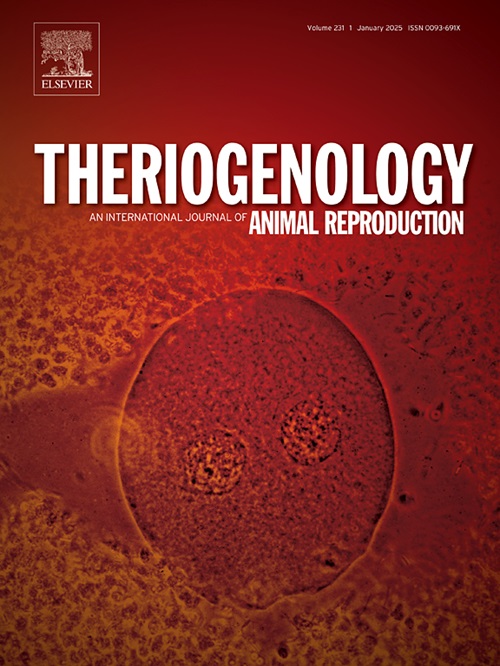Intrauterine growth restriction in newborn piglets associated with piglet characteristics, colostrum intake, litter size and parity number in prolific sows
IF 2.4
2区 农林科学
Q3 REPRODUCTIVE BIOLOGY
引用次数: 0
Abstract
The genetic selection of highly prolific sows has increased the number of fetuses within the uterus, directly affecting piglet quality due to limited placental space. This results in placental insufficiency and fetal intrauterine growth restriction (IUGR). This study aimed to investigate the incidence of IUGR in newborn piglets within a commercial swine herd under tropical conditions and to examine its association with piglet characteristics, birth order, litter size, sow parity, colostrum intake, and mortality rate during the first 24 h of life. The experiment was conducted in a commercial swine herd in Thailand. Data were collected from 114 litters of French Landrace × Yorkshire crossbred sows. Immediately after birth, the degree of IUGR was determined in 1868 piglets, comprising 1743 live-born and 125 stillborn piglets. Sows were categorized into four groups based on parity number: 1 (n = 28), 2 (n = 34), 3–5 (n = 33), and 6–8 (n = 19). Litters were further classified by total litter size into three categories: 7–14 (n = 18), 15–19 (n = 51), and ≥20 piglets (n = 45). On the day of parturition, IUGR was visually assessed in both live-born and stillborn piglets. Various farrowing and piglet parameters were recorded, including farrowing duration and litter traits. Birth weight was measured before and after colostrum ingestion, and individual colostrum intake was calculated. The incidence of IUGR in newborn piglets was 16.2 % (302/1868 piglets), with moderate and severe IUGR observed in 10.8 % and 5.4 % of piglets, respectively. The percentage of IUGR piglets in litters with 7–14 piglets (8.5 %) was lower than in litters with 15–19 piglets (17.1 %, P = 0.008) and ≥20 piglets (17.2 %, P = 0.005). IUGR piglets exhibited significantly lower birth weights (832 ± 28.6 g vs. 1274 ± 16.8 g, P < 0.001) compared to normal piglets. They also consumed less colostrum (257.1 ± 14.2 g vs. 414.3 ± 7.4 g, P < 0.001) and had a higher percentage of individuals with insufficient colostrum intake (<300 g) (77.3 % vs. 27.6 %, P < 0.001). At 24 h postpartum, IUGR piglets exhibited lower rectal temperatures (37.7 ± 0.1 vs. 38.1 ± 0.1 °C, P < 0.001) compared to normal piglets. Additionally, IUGR piglets experienced a higher mortality rate within the first 24 h of life compared to normal piglets (18.5 % vs. 6.1 %, P < 0.001). In conclusion, the results demonstrate that IUGR piglets exhibit lower birth weights, reduced colostrum intake, and poorer thermoregulation. These factors contribute to the higher mortality rate observed in IUGR piglets compared to their normal counterparts. Moreover, the proportion of IUGR piglets increases with larger litter sizes, emphasizing the impact of uterine crowding. This study underscores the importance of managing sow productivity to minimize the prevalence of IUGR and improve piglet survival and welfare.
新生仔猪的宫内生长限制与仔猪特征、初乳摄入量、产仔数和胎次数的关系
高产母猪的遗传选择增加了子宫内胎儿的数量,由于胎盘空间有限,直接影响仔猪质量。这导致胎盘功能不全和胎儿宫内生长受限(IUGR)。本研究旨在调查热带条件下商品猪群新生仔猪IUGR的发病率,并研究其与仔猪特征、出生顺序、产仔数、母猪胎次、初乳摄入量和出生后24小时死亡率的关系。该实验在泰国的一个商业猪群中进行。数据来自114窝法国长×大杂交母猪。出生后立即测定1868头仔猪的IUGR程度,包括1743头活产仔猪和125头死产仔猪。根据胎次数将母猪分为4组:1 (n = 28)、2 (n = 34)、3-5 (n = 33)和6-8 (n = 19)。按窝数分为7 ~ 14头(n = 18)、15 ~ 19头(n = 51)和≥20头(n = 45)。在分娩当天,对活产和死产仔猪进行IUGR目测评估。记录产仔和仔猪的各项参数,包括产仔时间和产仔性状。测定初乳摄取量前后的出生体重,计算个体初乳摄取量。新生仔猪IUGR发生率为16.2%(302/1868头),中度和重度IUGR发生率分别为10.8%和5.4%。7 ~ 14头仔猪窝中IUGR仔猪比例(8.5%)低于15 ~ 19头仔猪窝(17.1%,P = 0.008)和≥20头仔猪窝(17.2%,P = 0.005)。IUGR仔猪的出生重(832±28.6 g比1274±16.8 g)显著降低,P <;0.001)。他们也消耗较少的初乳(257.1±14.2 g vs. 414.3±7.4 g)。0.001),并且初乳摄入不足(300 g)的个体比例更高(77.3%比27.6%,P <;0.001)。产后24 h, IUGR仔猪直肠温度较低(37.7±0.1°C比38.1±0.1°C, P <;0.001)。此外,与正常仔猪相比,IUGR仔猪在出生后24小时内的死亡率更高(18.5%比6.1%,P <;0.001)。综上所述,IUGR仔猪初生重较低,初乳摄入量减少,体温调节能力较差。这些因素导致IUGR仔猪的死亡率高于正常仔猪。此外,IUGR仔猪的比例随着产仔数的增加而增加,这强调了子宫拥挤的影响。本研究强调了管理母猪生产力的重要性,以尽量减少IUGR的流行,提高仔猪的存活率和福利。
本文章由计算机程序翻译,如有差异,请以英文原文为准。
求助全文
约1分钟内获得全文
求助全文
来源期刊

Theriogenology
农林科学-生殖生物学
CiteScore
5.50
自引率
14.30%
发文量
387
审稿时长
72 days
期刊介绍:
Theriogenology provides an international forum for researchers, clinicians, and industry professionals in animal reproductive biology. This acclaimed journal publishes articles on a wide range of topics in reproductive and developmental biology, of domestic mammal, avian, and aquatic species as well as wild species which are the object of veterinary care in research or conservation programs.
 求助内容:
求助内容: 应助结果提醒方式:
应助结果提醒方式:


